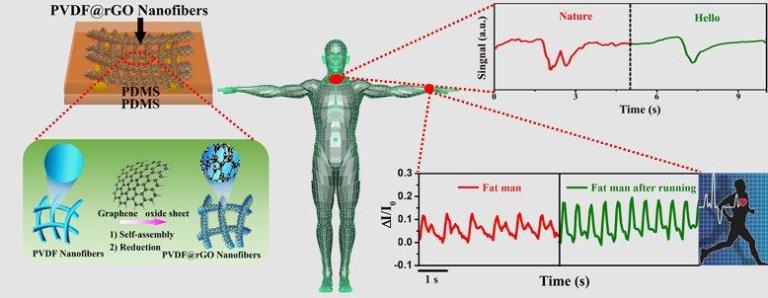
Electronic skin (e-skin) which can mimic pressure, humidity, and temperature sensing capabilities of human skin has obtained great attention due to its superior abilities to detect slight pressure changes. It has potential application in human health monitoring, medical diagnostics, tactile sensor, artificial intelligence, and so on. Tactile sensor, which can act as transducers to convert the changes in external force to an electrical signal or other recognized signal, is a fundamental part of e-skin. So, design of tactile sensors with ultra-sensitivity, rapid response speed and long-term stability is a key procedure to fulfill high performance electronic skins.
Recently, Prof. SHEN Guozhen and his group (from Institute of Semiconductors) have fabricated a new type of graphene based flexible tactile sensor which achieves a similar function of human skin. The sensor can exhibit high sensitivity (15.6 kPa-1), low detection limit (1.2 Pa) which enabled to detect a feather or a rice grain. The excellent long-term stability under 100,000 cycles and rapid response time of 5 ms at 50 Hz are particularly captivating.
This flexible tactile sensor has been used in the medical field to monitor the human physiological signal in real-time, such as pulse and voice recognition through the slight pressure changes of blood flow and the muscle movement during speech.
This study preliminary realized voice recognition and different human physiological states monitoring which have the great potential application in voice auxiliary output system, human health assessment and early diagnosis of the disease. Besides, using the simple and versatile procedures, a framework to make integrated sensor array platforms easily can be used as highly sensitive electronic skins for mapping spatial pressure distribution.
This work provides a new idea for electronic skin and wearable health monitoring systems. After further research and improvement, the flexible multidimensional tactile sensor array not only have a great flexibility like human skin, but also have the functional to get the 3D force information.
The work was supported by the National Natural Science Foundation of China, and the corresponding paper entitled “An ultra-sensitive and rapid response speed graphene pressure sensors for electronic skin and health monitoring” was published in Nano Energy.

Device structure and applications in electronic skins and health monitoring. (Image by Prof. SHEN Guozhen et al.)

86-10-68597521 (day)
86-10-68597289 (night)

52 Sanlihe Rd., Xicheng District,
Beijing, China (100864)

